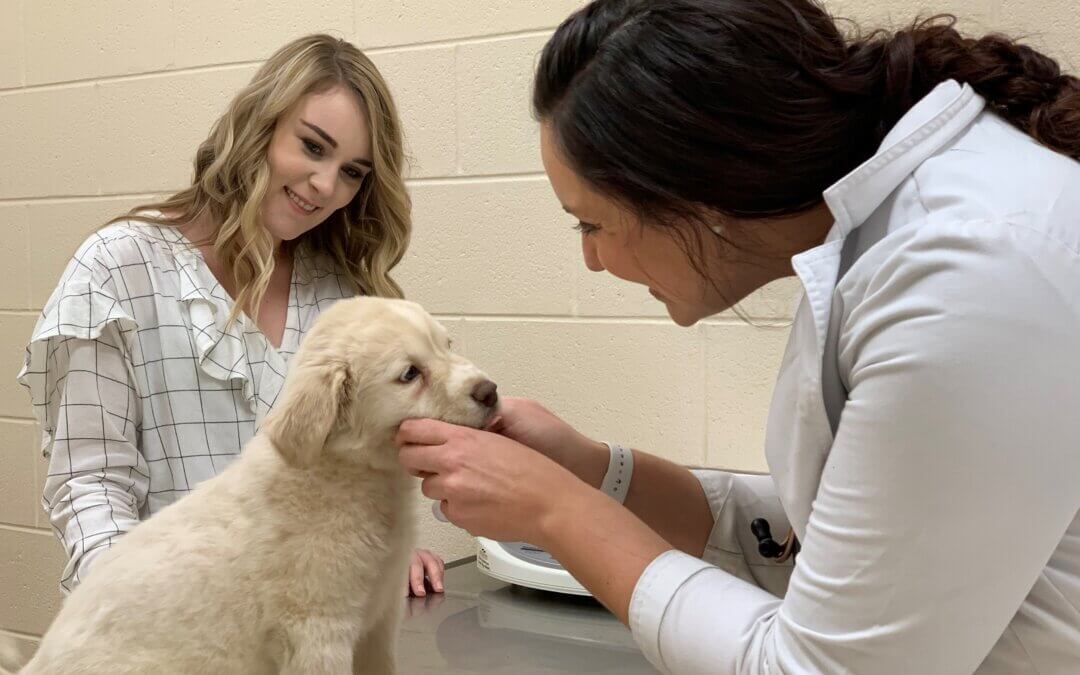The article below was written by Michigan Humane Vice President, Veterinary Medicine, Dr. Crystal Sapp, DVM and Michigan Humane Director of Advocacy, Ann M. Griffin.
When our pets require medical care, we’re not thinking about – or even familiar with – the legal formalities of entering into a veterinarian-client-patient relationship (VCPR). But veterinarians are required to comply with any federal and state laws on creating a VCPR before providing services. Failure to do so could result in disciplinary action, including the loss of their license to practice veterinary medicine.
According to the American Veterinary Medical Association (AVMA), a VCPR “is the basis for interaction among veterinarians, their clients, and their patients and is critical to the health of animals.” The AVMA’s Principles of Veterinary Medical Ethics require that “[a] veterinarian shall provide competent veterinary medical clinical care under the terms of a veterinarian-client-patient relationship (VCPR).”
In addition to being an ethical requirement, there are a few federal laws that require veterinarians to establish a VCPR before providing certain services. Most state’s laws or administrative rules require and regulate the creation of a VCPR before a veterinarian can provide services. While the details may differ, the law generally requires that to create a VCPR, a veterinarian must have sufficient knowledge of the patient to make a clinical assessment of the patient’s health and provide treatment, and the veterinarian must have assumed responsibility for doing so.
Michigan is one of the few states that currently does not have a state law or administrative regulation requiring a VCPR. (A previous administrative rule issued by the Board of Veterinary Medicine providing the criteria to be met to establish a VCPR was enacted in 2011 and repealed in 2016.) Currently, with the exception of the specific issues covered by the federal VCPR requirements, Michigan veterinarians are not legally required to practice within the scope of a VCPR.
Both the Michigan legislature and the Board of Veterinary Medicine are considering rules that would regulate the use of telehealth. The bills being considered by the Michigan legislature address the telehealth issue in the context of requiring a VCPR. A major point of contention between these two regulatory bodies is whether an in-person examination of the patient is required before rendering services via telehealth.
To fully understand what this means, we need to understand the terminology. According to the AVMA, veterinary telehealth is defined as an overarching term that describes all uses of technology to deliver healthcare information, education, and services remotely. The AVMA breaks down the umbrella term telehealth into subcategories: telemedicine, teletriage, tele-advice, teleconsulting, telecommunication, telesupervision, telemonitoring, e-VFD, and e-prescription. Based on the AVMA definitions, telemedicine is a subcategory of telehealth that involves the digital exchange of information from a distance regarding a patient’s clinical health status within an existing VCPR. Though the AVMA distinguishes between the two, telehealth and telemedicine are often used interchangeably in literature and clinical settings. It is apparent that there is not a broad consensus or strict definition.
The primary benefit of telehealth for a veterinary practice is to provide tele-triage, answer simple inquiries a client might have about their pet or for their pet, and provide discussion-based care in a convenient and cost-effective way, which also helps to lessen the burden on emergency facilities. This service can even assist general practitioners if using a telehealth company to support their clients that aren’t at the facility with their pet. Virtual interaction is helpful even after a traditional visit to help with follow-up questions or recheck on how an animal is doing after starting a new medication or therapy, in post-surgical evaluation, evaluation of disease progression or therapeutic success, and palliative care.
Telemedicine is not without potential risks though, and there are scenarios where this would not be appropriate. The biggest risks to a DVM or practice are the risk that the DVM would infer a diagnosis and/or suggest treatment without sufficient knowledge of the animal and the risk of client involvement in a physical assessment of the animal. This outlines the importance of having an already established and thorough understanding of the animal when considering telehealth options. The safest way to do so is to perform a physical exam on the animal and gather a thorough history from the client before utilizing telemedicine in the practice. Veterinarians must have a thorough understanding of the legalities surrounding telehealth work in their area.
The COVID-19 pandemic spurred the use of telehealth services here in Michigan as only essential work was to be performed during a period of time when personal protective equipment was scarce. Since a lot of organizations pivoted to work-from-home options, clients were home more with their animals and were more available to take their pet to the vet. There were also a lot of adoptions during this time since people weren’t traveling as much and were home more. The need for veterinary care increased during this time due to these factors as well as the shortage of veterinary professionals already in play. Clients liked the convenience and safety of not having to bring their pet to the vet all of the time and were more interested in telehealth options when available.
As it pertains to our work here at Michigan Humane, the addition of telehealth services will be vital to ensuring we can meet people where they are. If they are unable to leave their house, are disabled, lack transportation, have a general question but cannot get into the clinic because it’s booked, cannot establish care with a veterinarian because there isn’t a clinic near them that’s accepting new patients or even a clinic near enough to be able to visit if they were accepting new clients, they need another way to connect with a veterinarian. Utilizing telehealth services for follow-up care takes an already established relationship and expands on the options of care for that animal. It can also help us to establish the urgency of the need if we are able to connect remotely ahead of time and would allow us to work with our Field Services and Community Solutions teams as well to care for the household as a whole and keep pets with their families.
In April 2021, in apparent recognition of the benefits of telehealth, the Board of Veterinary Medicine promulgated rules specifically to govern its use. While these rules do not refer to a VCPR requirement, they do require “sufficient knowledge of the animal patient to render telehealth services.” One of the ways such knowledge can be obtained is “through the use of instrumentation and diagnostic equipment through which images and medical records may be transmitted electronically.” A Michigan veterinarian who observes all of the regulatory requirements for the use of telehealth is currently allowed to do so, regardless of whether the veterinarian has previously examined the patient in person.
The Board of Veterinary Medicine published draft changes to its rules in January 2022. Included in that draft was a change to the telehealth rules striking the language allowing sufficient knowledge of the animal patient to be acquired “through the use of instrumentation and diagnostic equipment through which images and medical records may be transmitted electronically.” Instead, the draft rules require that “[e]xcept in the case of an emergency,[the veterinarian must] haverecently examined the animal patient in person.” What constitutes an “emergency” is not defined. The draft rules are pending.
The Michigan legislature is considering changes to the Public Health Code pertaining to the practice of veterinary medicine, including rules for establishing a VCPR and whether that can be achieved through telehealth. Introduced in May 2021, the original version of HB 4912 included the criteria for establishing a VCPR, including having “sufficient knowledge of the patient” and requiring the veterinarian to have “recently seen and be personally acquainted with the keeping and care of the patient by the client by virtue of examining the patient or by medically appropriate and timely professional visits to the location where the patient is kept.” The original draft included an exception for the use of telehealth before establishing a VCPR in an emergency, but required that “the veterinarian shall make a good-faith
effort to arrange an in-person visit as soon as practicable to establish a veterinarian-client-patient relationship.”
The bill was revised several times, and hearings were held in both the House Agriculture and House Rules & Competitiveness Committees. As a result of those hearings and extensive input regarding the telehealth provisions, the version of HB 4912 that passed the House was very different from the version that was originally introduced. The section pertaining to the creation of a VCPR was moved to a separate bill, HB 5804, which is tie-barred to HB 4912 (which means that both bills must pass to become law). HB 5804 would allow a VCPR to be created by a veterinarian who “obtained current knowledge of the animal through the use of instrumentation and diagnostic equipment through which images and medical records may be transmitted electronically.” The bills have been assigned to the Senate Agriculture Committee. The legislature has until the end of the current legislative session (December 31, 2022) to act on HB 4912 and HB 5804, or the bills will die.
The pending changes to the Board of Veterinary Medicine rules and the Public Health Code are contradictory with respect to the use of telehealth. These regulatory bodies have each changed course and have maintained opposing positions regarding whether a veterinarian must first examine a patient in person before using telehealth. We are closely monitoring the situation.
We are going to keep working to improve animal welfare and create a more humane community while serving as a voice for the animals through advocacy. Together, we can continue to make a difference in animals’ lives. If you know someone who you think would be interested in this information, please forward this to them and encourage them to sign up for our Legislative Action Network.
Photo Credit: Michigan Humane

